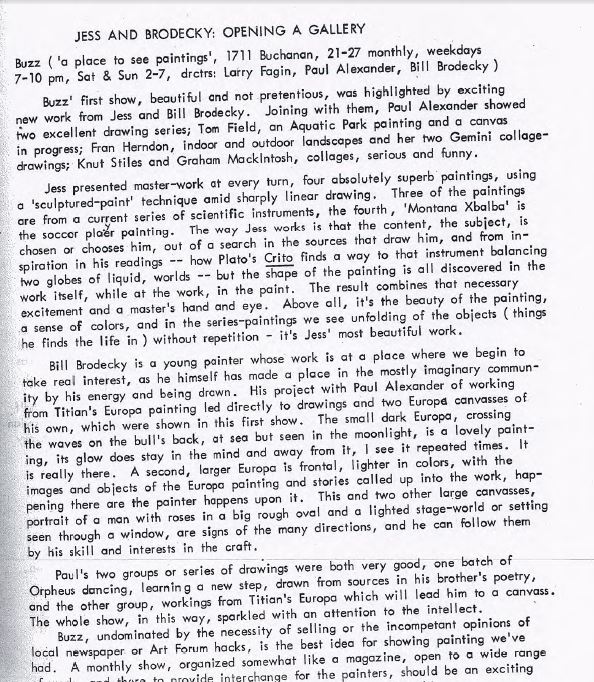-------------------------------------------------------
Open Space, published by Stan Persky, appeared monthly (with 3 bonus issues) in 1964. It's fifteen issues document a year of activity (literary or otherwise) in the Spicer circle. (Spicer would be dead less than nine months after the final issue.) Famously, submissions were accepted via a mailbox inside of a favorite North Beach bar, Gino & Carlo's. The poem above, for being chosen as the winner of the Open Space Valentine's Day contest, apparently won Spicer five free drinks. From the start, Persky intended the magazine to serve as an "actual working place" for his friends and as a vehicle for discovering interesting new work from the young poets flocking to San Francisco. While latter goal proved a continuous struggle, Open Space saw a tremendous amount of work produced on its pages.
As noted in Poet Be Like God,
"about half the text of [Robert] Duncan's book, Bending the Bow, first appeared in the magazine. All of [Robin] Blaser's current work, too---"The Moth Poem," "The Holy Forest," and the early Image-Nations series---found their way into Open Space. And in a real sense, Open Space kept Spicer alive in 1964---its very regularity helped to provide a rhythm in which to situate his final two books. He composed almost the entirety of Language for Open Space, beginning with "Thing Language"---his first poem since the "Fix" series of October 1962."
Many of these well known poems appear in early versions. Duncan's Bending the Bow, for example, was published as a series of numbered "Passages." Titles were issued retroactively with a note in issue seven:
Also included was work from Jess, including various artwork, writing, and collage, as well as early appearances from his "Critical Dreams" series and a few instances of "Tricky Cad." Poems from George Stanley appear throughout and in later issues many are published in draft form.
Other poets making frequent appearances in Open Space include Stan Persky, Lewis Ellingham, Helen Adam, "Lawrence" Fagin, Lawrence Kearney, James Alexander, Joanne Kyger, Harold Dull, Richard Duerden, Link, and other members of the scene---both major and minor.
The real treasures are in the reviews & commentary section that closes nearly every issue. Variously called "Home & Garden", "Muse News," or "Report to the Stockholds", the last few pages contain reviews of books, readings, or art exhibitions, along with letters to the editor (often from Spicer) and gossip, general attacks, and bitchiness. It all perfectly illustrates the playful nastiness or nasty playfulness the Spicer circle was famous for. There's also useful comments and criticism. This note, from number ten, takes issue with an attempt from The Nation to stop Duncan from referencing homosexuality in a review of John Wieners' Ace of Pentacles:
In issue six, a lengthy review of in praise of a show of paintings from Jess and Bill Brodecky is directly followed by a review calling a reading given by Lew Welch, Philip Whalen, and Gary Snyder "the worst poetry reading I've ever been to, [at] the worst place to hold one": In issue nine, a 3 page review of Lawrence Kearney's Fifteen Poems by George Stanley is followed by two pages of Gino & Carlo's bar gossip by Lewis Ellingham. Stanley's review is a thing of beauty, but can it compete with a story about Jack Spicer thwarting an armed robbery by being the only person at the bar able to recognize the "gun" as a water pistol?
Read them all here:
Open Space Prospectus
Open Space #1
Open Space Valentine
Open Space #2
Open Space #3
Open Space Taurus Issue
Open Space #4
Open Space #5
Open Space #6
Open Space #7
Open Space #8
Open Space #9
Open Space #10
Open Space #11
Open Space #12
------------------------------------
The files above are reading copy quality scans of barely decent photocopies I made from a Kraus Reprint edition of Open Space published in 1971. (This was presumably made from the set, again according to Poet Be Like God, sold by Lewis Ellingham to the Bancroft Library for bus fare to New York.) In other words, a copy of a copy of a copy, which had certain inlays and inserts missing to begin with. And although I was careful, it's entirely possibly that pages may be missing or out of order. In other words, this shouldn't be considered a clean or complete representation. -------------------------------------
Karl Saffran works here.









